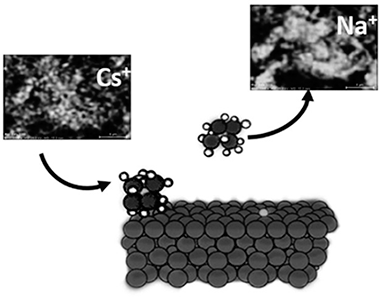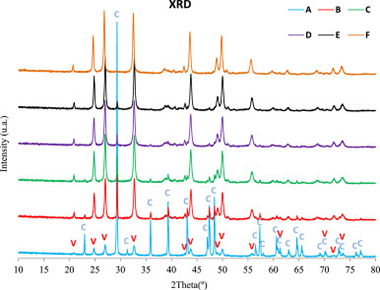Artículos SCI
2018
2018
Materiales de Diseño para la Energía y Medioambiente
Cesium adsorption isotherm on swelling high-charged micas from aqueous solutions: Effect of temperature
Osuna, FJ; Cota, A; Pavon, E; Pazos, MC; Alba, MDAmerican Mineralogist, 103 (2018) 623-628
Show abstract ▽

The potential use of a new family of synthetic swelling micas for cesium immobilization from aqueous solution was evaluated and the structural modifications after adsorption were analyzed. The results have revealed that they are good cesium adsorbents compared to natural clays and as the layer charge increases, the adsorption capacity and affinity increase. The cesium ions are adsorbed through a cation exchange mechanism, but an inner sphere complex with the basal O atoms of the tetrahedral sheet is favored. These findings imply that is possible to design minerals with improved environmental applications.
Abril, 2018 | DOI: 10.2138/am-2018-6203
Materiales Coloidales
Photoluminescence quenching of dye molecules near a resonant silicon nanoparticle
Zyuzin, MV; Baranov, DG; Escudero, A; Chakraborty, I; Tsypkin, A; Ushakova, EV; Kraus, F; Parak, WJ; Makarov, SVScientific Reports, 8 (2018) art. 6107
Show abstract ▽
Luminescent molecules attached to resonant colloidal particles are an important tool to study light-matter interaction. A traditional approach to enhance the photoluminescence intensity of the luminescent molecules in such conjugates is to incorporate spacer-coated plasmonic nanoantennas, where the spacer prevents intense non-radiative decay of the luminescent molecules. Here, we explore the capabilities of an alternative platform for photoluminescence enhancement, which is based on low-loss Mie-resonant colloidal silicon particles. We demonstrate that resonant silicon particles of spherical shape are more efficient for photoluminescence enhancement than their plasmonic counterparts in spacer-free configuration. Our theoretical calculations show that significant enhancement originates from larger quantum yields supported by silicon particles and their resonant features. Our results prove the potential of high-index dielectric particles for spacer-free enhancement of photoluminescence, which potentially could be a future platform for bioimaging and nanolasers.
Abril, 2018 | DOI: 10.1038/s41598-018-24492-y
Nanotecnología en Superficies y Plasma
Enhancing Moisture and Water Resistance in Perovskite Solar Cells by Encapsulation with Ultrathin Plasma Polymers
Idigoras, J; Aparicio, FJ; Contreras-Bemal, L; Ramos-Terron, S; Alcaire, M; Sanchez-Valencia, JR; Borras, A; Barranco, A; Anta, JAACS Applied Materials & Interfaces, 10 (2018) 11587-11594
Show abstract ▽

A compromise between high power conversion efficiency and long-term stability of hybrid organic inorganic metal halide perovskite solar cells is necessary for their outdoor photovoltaic application and commercialization. Herein, a method to improve the stability of perovskite solar cells under water and moisture exposure consisting of the encapsulation of the cell with an ultrathin plasma polymer is reported. The deposition of the polymer is carried out at room temperature by the remote plasma vacuum deposition of adamantane powder. This encapsulation method does not affect the photovoltaic performance of the tested devices and is virtually compatible with any device configuration independent of the chemical composition. After 30 days under ambient conditions with a relative humidity (RH) in the range of 35-60%, the absorbance of encapsulated perovskite films remains practically unaltered. The deterioration in the photovoltaic performance of the corresponding encapsulated devices also becomes significantly delayed with respect to devices without encapsulation when vented continuously with very humid air (RH > 85%). More impressively, when encapsulated solar devices were immersed in liquid water, the photovoltaic performance was not affected at least within the first 60 s. In fact, it has been possible to measure the power conversion efficiency of encapsulated devices under operation in water. The proposed method opens up a new promising strategy to develop stable photovoltaic and photocatalytic perovskite devices.
Abril, 2018 | DOI: 10.1021/acsami.7b17824
Materiales Avanzados
Synthesis of vaterite CaCO3 as submicron and nanosized particles using inorganic precursors and sucrose in aqueous medium
Perez-Villarejo, L; Takabait, F; Mahtout, L; Carrasco-Hurtado, B; Eliche-Quesada, D; Sanchez-Soto, PJCeramics International, 44 (2018) 5291-5296
Show abstract ▽

It is reported the synthesis of CaCO3 vaterite as stable nanoparticles and submicron-sized by a simple and relatively rapid procedure. XRD, SEM and FTIR techniques have been used to characterize the precipitated products. The synthesis is based on chemical precipitation of inorganic salt precursors, calcium nitrate tetra hydrate and sodium bicarbonate, and using the disaccharide sucrose as an additive in aqueous medium. The role of the disaccharide sucrose is to control the vaterite precipitation after nucleation and growth. It has been found that an increase in sugar concentration promotes the crystal precipitation of vaterite with spherulitic morphology, as revealed by SEM, and changed the surface of the precipitated particles. There is a significant difference between CaCO3 precipitation in the absence and presence of sucrose. Addition of 0% of sucrose leads to 83% of calcite as identified by XRD methods. In contrast, addition of 67% of sucrose in aqueous medium produces 100% vaterite. The present results may be useful to provide a quick, simple, inexpensive and novel method for the controlled synthesis of new advanced biomaterials based on vaterite particles without hazardous chemicals and inert atmosphere, with great possibilities for industrial scale production.
Abril, 2018 | DOI: 10.1016/j.ceramint.2017.12.142
Nanotecnología en Superficies y Plasma
Electrophoretic deposition of mixed copper oxide/GO as cathode and N-doped GO as anode for electrochemical energy storage
Jafari, EA; Moradi, M; Hajati, S; Kiani, MA; Espinos, JPElectrochimica Acta, 268 (2018) 392-402
Show abstract ▽

In this work, energy storage properties of mixed copper oxide wrapped by reduced graphene oxide and nitrogen-doped reduced graphene oxide were investigated. First, co-electrophoretic deposition technique was used to coat GO@CuO on nickel foam; followed by electrochemical phase transformation to rGO@CuxO. Electron spectroscopy analyses (XPS, REELS and UPS) confirm the phase transformation and electrochemical reduction. Then, an electrophoretic deposition was carried out for coating nitrogen-doped graphene oxide on nickel foam coupled to its electrochemical reduction to the NrGO. The cathode and anode performances were studied by galvanostatic charge-discharge, cyclic voltammetry and impedance spectroscopy. The rGO@CuxO and NrGO exhibit a favorable specific capacity of 267.2 and 332.6 C g(-1) at 2 A g(-1), respectively. High electrochemical activity and elimination of polymer binders with a maximum potential of 1.6 V are among the advantages of rGO@CuxO//NrGO electrochemical charge storage device. Furthermore, fabricated device provided a maximum specific power and specific energy of 11917.24 W kg(-1) and 14.15 Wh kg(-1), respectively, with 86% capacity retention after 2000 cycles.
Abril, 2018 | DOI: 10.1016/j.electacta.2018.02.122
- ‹ anterior
- 169 of 420
- siguiente ›














